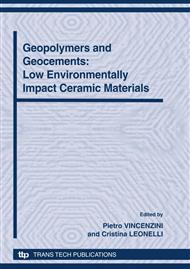[1]
G. Tchobanolous, F.L. Burton, H.D. Stensel, Wastewater Engineering Treatment and Reuse, 4th Ed., McGraw-Hill (2003).
Google Scholar
[2]
A. Sonune, R. Ghate: Desalination Vol 167 (2004), p.55.
Google Scholar
[3]
B. Van der Bruggen, L. Braeken: Desalination Vol 188 (2006), p.177.
Google Scholar
[4]
M.D. Bermejo, M.J. Cocero: Journal of Hazardous Material Vol 137 (2006), p.965.
Google Scholar
[5]
A. Bozzi, T. Yuranova, P. Lais, J. Kiwi: Water Research Vol 39 (2005), p.1441.
Google Scholar
[6]
K. Laursen, L.D. Benefield, C.W. Randall, Biological Process Design for Wastewater Treatment, Prentice-Hall Inc, (1980).
Google Scholar
[7]
M. Izquierdo, X. Querol, C. Phillipart, Charles, D. Antenucci: World of Coal Ash: Science, Applications and Sustainability, Proceedings, 3rd, Lexington, KY, United States (2009).
Google Scholar
[8]
A. Fernandes-Jimenez, A. Palomo: Cem. Concr. Res. Vol 35 (2005), p. (1984).
Google Scholar
[9]
J. Davidovits: J. Therm. Anal. Vol 37 (1991), p.1633.
Google Scholar
[10]
A. Palomo, M. Grutzeck, M. Blanco: Cem. & Con. Res. Vol 29 (1999), p.1323.
Google Scholar
[11]
H. Xu, J. van Deventer: Int. J. Min. Proc. Vol 59 (2000), p.247.
Google Scholar
[12]
H. Xu, J. van Deventer: Min. Eng. Vol 15 (2002), p.1131.
Google Scholar
[13]
C. Fernandez-Pereira, Y. Luna, X. Querol, D. Antenucci, J. Vale: Fuel Vol 88 (2008), p.1185.
Google Scholar
[14]
T. Hanzlicek, M. Steinerova, P. Straka: J. Am. Ceram. So. Vol 89(11) (2006), p.3541.
Google Scholar
[15]
D. Tavor, A. Wolfson, A. Shamaev, A. Shvarzman: Ind. Eng. Chem. Res. Vol 46 (2007), p.6801.
DOI: 10.1021/ie0616996
Google Scholar
[16]
D. Khale, R. Chaudhary, Rubina: J. oSo. Waste Tech. & Man. Vol 33 (3) (2007), p.148.
Google Scholar
[17]
J. Zhang, J.L. Provis, D. Feng, J. s. j. van Deventer: J. Haz. Mat. Vol 157(2-3) (2008), p.587.
Google Scholar
[18]
J. Davidovits: J. Mater. Educ. Vol 16 (1994), p.91.
Google Scholar
[19]
W. Sun, Y. Zhang, W. Lin, Z. Liu: Cement & concrete Res. (2004) Vol 34, p.935.
Google Scholar
[20]
A. Shvarzman , K. Kovler, G. Grader, G. Shter: International Symposium on Non-Traditional Cement & Concrete, (2002), Brno.
Google Scholar
[21]
J. Swanepoel, S. Strydom: App. Geochem. Vol 17 (2002), p.1143.
Google Scholar
[22]
S. Zhang, K. Gong, J. Lu: Mat. Lett. Vol 58 (2004), p.1292.
Google Scholar


